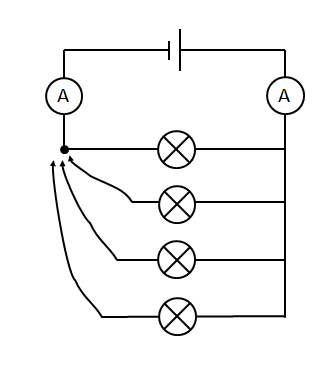It is a long-standing and melancholy truth that, despite the best efforts of many legions of Physics teachers, many students continue to not only dislike electricity, but to hate it with the white-hot intensity of a million suns.
What we have here, I think, is a classic failure to communicate.
A final fact is that samenesses and differences of examples are more obvious when the examples are juxtaposed. This fact implies that the continuous conversion of examples provides the clearest presentation of samenesses and, differences because it creates the changes that occur from one example to the next.
— Siegfried Engelmann and Douglas Carmine, Theory of Instruction (1982) p.46
Looking at my own teaching, I certainly attempt to juxtapose a number of circuits. I really want to highlight the similarities and differences between circuits in order to better develop my students’ understanding. But the problem is that both limited resources and other practical considerations mean that the juxtapositioning cannot happen by continuous conversion, except very rarely.
For example, I would set up (or ask students to set up) a circuit with a single bulb with an ammeter, then I (or we) would disassemble the circuit and rebuild it with the ammeter in a different position, or a second bulb added in series or in parallel . . .
It occurs to me that what we are relying on to thread these juxtapositions together in students’ minds is a sequence of circuit diagrams. I suppose it’s another case of the curse of knowledge writ large: experts and novices think differently.
As a beginning teacher, I remember being genuinely shocked that many students found it easier to interpret a photograph or a 3D drawing rather than the nice, clutter-free, minimalist lines of a circuit diagram.
Without a doubt, many students retain strong visual impressions of many of the circuit diagrams they encounter, but they do not parse and decode the diagrams in the same way as their teachers do.
And that, I think, is the major problem when we are introducing electric circuits.
But what to do?
— R. S. Thomas, The Cure
Can we introduce the important aspects of electrical circuits by continuous conversion of examples?
I think we can. And what is more, I think it will be more effective than the itty-bitty assembly and disassembly of circuits that I have practiced to date.
Conservation of electrical current (and current in parallel circuits) by continuous conversion

This is introduced with a teacher demonstration of the above circuit. Students are invited to note the identical readings on both ammeters and asked to explain why they are identical. They are then asked to predict the effect of adding a second bulb in parallel. The teacher then adds the second bulb by connecting the flying lead. The process is repeated with the third and fourth bulbs, with the teacher testing students’ understanding by asking them to predict the change in current readings as bulbs are added and removed. The teacher also tests students’ understanding of the conservation of current by asking students to predict whether the reading on both ammeters will be the same or different as bulbs are added and removed.
I find it useful to include a bulb that is not identical to the other three. It should be noticeably brighter or dimmer than the other three with the same p.d. so that students do not make the incorrect inference that the current always increases or decreases in equal steps when the circuit is changed.
The teacher could also draw the original circuit on a student whiteboard and ask students to do likewise. The changes that are about to be made could be described and students could be asked could alter the picture/circuit diagram and write their prediction on their whiteboards. They could then compare their version with the teacher’s and their prediction could be quickly tested by making the proposed changes “live” in front of the students.
If resources and time permit, students could then, of course, go on to construct their own parallel circuits as a class practical. However, I think it is important that these vital, foundational ideas are introduced (or re-introduced!) via a teacher demonstration to avoid possible cognitive overload for students.
Series circuits by continuous conversion

In this demonstration circuit, four of the three bulbs are short-circuited so that they are initially unlit. The teacher asks students to explain only one bulb in the circuit is lit: it is helpful if they have previously encountered parallel circuits and can explain this in terms of electrical current taking the “easier” route (assuming they have not yet encountered the concept of electrical resistance).
Again, the two ammeters allow the teacher to emphasise and test students understanding of the idea that current is conserved.
The teacher then asks students to predict the change in current reading when switch X is opened: will it increase or decrease? Why would it increase or decrease? The process is repeated with switches Y and Z and students’ understanding is tested by asking them to predict the effect on the current reading of opening or closing X, Y or Z.
As before, the teacher would amend her circuit diagram on her student whiteboard and students would do likewise. For example: “I am going to open switch Y. Change the circuit diagram. Show me. What will happen to the reading on the left hand ammeter? What will happen to the reading on the right hand ammeter? Explain why.”
Again, I recommend that at least one out of the four bulbs in not identical to the other three to help prevent students from drawing the incorrect inference that the current will always increase or decrease in identical steps.
Reblogged this on The Echo Chamber.
Cheers. I’ll give this a go next year!
This appears to be a form of Predict-Observe-Explain iirc.